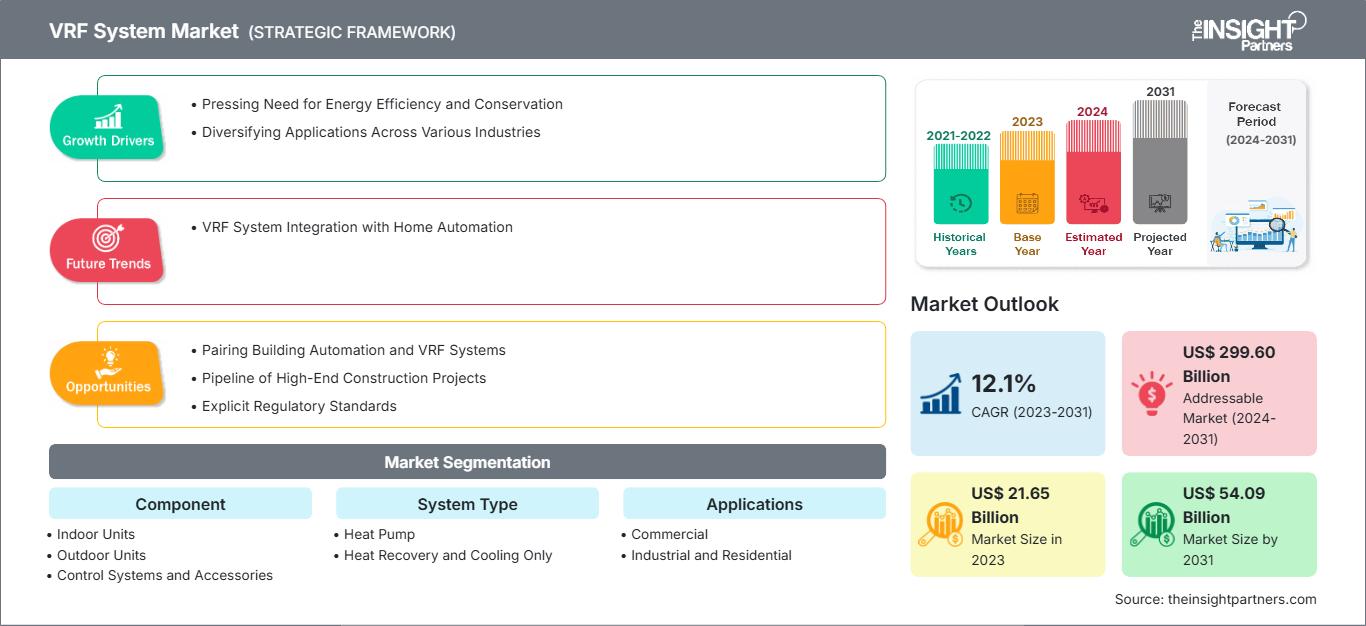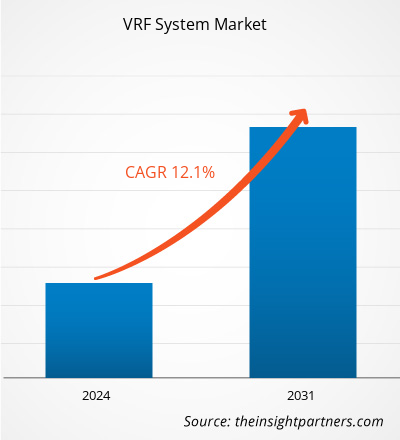VRF 系统市场规模预计将从 2023 年的 216.5 亿美元增至 2031 年的 540.9 亿美元。预计该市场在 2023 年至 2031 年期间的复合年增长率将达到 12.1%。定制冷却风扇的需求不断增长,这可能是一个关键的市场趋势。
VRF 系统市场分析
VRF 系统提供更高的能源效率。与需要频繁开关的典型系统不同,VRF 系统可以在部分负荷下持续运行,从而显著提高整体运行效率。它可以配备热回收功能,将一个空间回收的热量用于调节建筑物内其他需要热量的区域,反之亦然,从而提高系统的整体效率。 VRF系统通常比同类产品更小巧轻便,更易于安装和移动,同时还能节省宝贵的天花板高度和地板面积。
对节能减排的迫切需求以及各行各业应用的多样化是推动VRF系统市场增长的主要因素。另一方面,较高的前期成本限制了市场的增长。然而,楼宇自动化与VRF系统的结合以及明确的监管标准为VRF系统市场创造了巨大的增长机会。VRF系统与家居自动化的集成可能会引领VRF系统市场未来的重大趋势。
VRF系统市场概览
VRF系统使用制冷剂进行供暖和制冷。VRF是一种大规模、高效的无管式暖通空调系统技术。与分体式空调不同,VRF系统可以在单个系统上支持多台室内机组,并可根据用户的独特需求进行定制。这类系统分为热回收系统或热泵系统。热回收VRF系统可以同时进行供暖和制冷。此外,VRF 系统配备多个可单独调节的空气处理器,即使在满负荷运转时也能保持安静运行。因此,这类系统既适用于工业应用,也适用于住宅应用。
自定义此报告以满足您的要求
您将免费获得任何报告的定制,包括本报告的部分内容,或国家级分析、Excel 数据包,以及为初创企业和大学提供超值优惠和折扣
VRF系统市场: 战略洞察

- 获取本报告的主要市场趋势。这个免费样本将包括数据分析,从市场趋势到估计和预测。
您将免费获得任何报告的定制,包括本报告的部分内容,或国家级分析、Excel 数据包,以及为初创企业和大学提供超值优惠和折扣
VRF系统市场: 战略洞察

- 获取本报告的主要市场趋势。这个免费样本将包括数据分析,从市场趋势到估计和预测。
VRF 系统市场驱动力与机遇
跨行业多元化应用
VRF 系统的运行涉及压缩机的持续运转,并根据需要将制冷剂策略性地引导至每个区域。VRF 系统体积小巧、能效高,并具有卓越的分区功能,可作为暖通空调 (HVAC) 解决方案,广泛应用于各行各业。这些系统安装在酒店、办公楼、公寓楼、学校、大学、宿舍、数据中心、医院、制造工厂、实验室设施、餐厅、大型零售场所以及任何需要同时对多个区域进行供暖和制冷的场所。无论房间入住人数多少,它们都能够以更安静的运行和个性化的分区提供舒适的体验。集中控制系统有助于在客人抵达前或退房后调节房间温度,从而显著节省成本。采用单冷凝器的 VRF 系统可以进一步节省能源。这些设备也可用作水源热泵,是配备冷却塔(为水冷式空气处理系统供能)的办公楼数据室的理想解决方案。水源冷凝机组非常紧凑,可安装在占地面积极小的本地设备室中。
从大型大学校园到小型小学,教育机构面临着各种房间带来的特殊挑战。从小型行政办公室到中型教室再到大型体育馆,每个房间都需要各种暖通空调设备。使用带有单个控制面板的VRF系统可以轻松满足所有这些不同的需求。在医院或临床环境中,空气质量和温度管理规范至关重要。空气会影响患者的康复。VRF系统可以在保持恢复室内低温的同时,保持大厅和公共通道的供暖或环境温度。因此,可以创建无管道泄漏的区域,从而更有效地过滤空气并最大限度地减少交叉污染。因此,各行各业的多样化应用推动了VRF系统市场的增长。
楼宇自动化与VRF系统的结合
楼宇自动化系统与VRF系统的结合可以更全面地控制能源使用。如今,工程师们正在利用建筑脱碳的长期效益。多年来,气候专家一直警告允许温室气体(GHG)排放的危险。北美已有20多个州设定了强制性脱碳目标,北美已有45多个州为在建筑物中使用电气设备提供公用事业激励措施。2024年2月,欧盟委员会宣布了一项新的气候目标,旨在到2040年将欧盟的温室气体排放量在1990年的水平上减少90%。该目标与欧洲气候变化科学咨询委员会提出的90%至95%的排放目标一致。VRF系统具有独特的优势,可以帮助建筑业主实现当前的二氧化碳减排目标,同时降低公用事业成本。该系统无需管道,是将老旧建筑升级到现代标准的理想之选。它们可以提供分区个性化的舒适度管理,并改善室内环境质量。VRF 系统与楼宇自动化系统 (BAS) 的集成,可增强其能源效率和成本效益。据参与“缩减项目”的科学专家称,楼宇自动化系统可提高供暖和制冷效率 20% 以上,同时降低照明、家电和其他设备的能耗 8%。在包括美国在内的高收入国家,BAS 的采用率在 0% 到 75% 之间。大幅提高采用率——初始净成本为 2877 亿美元到 3933.5 亿美元——可为建筑业主节省 2.27 万亿美元到 3.42 万亿美元的运营支出。到 2050 年,它还可以防止 9.55–14.01 亿吨二氧化碳排放。因此,将楼宇自动化与 VRF 系统配对可以为预测期内 VRF 系统市场的增长创造充足的机会。
VRF 系统市场报告细分分析
有助于得出 VRF 系统市场分析的关键细分是组件、系统类型和应用。
- 根据组件,市场细分为室内机、室外机、控制系统和配件。室外机部分在 2023 年占据了市场主导地位。
- 就系统类型而言,市场分为热泵、热回收和仅制冷。热泵部分在 2023 年占据了市场主导地位。
- 根据应用,市场细分为商业、工业和住宅。 2023年,商业领域占据了市场主导地位。
VRF系统市场份额按地区分析
- VRF系统市场分为五大区域:北美、欧洲、亚太地区 (APAC)、中东和非洲 (MEA) 以及南美和中美。2023年,亚太地区占据了市场主导地位,其次是欧洲和北美。
- 气温升高和天气变化无常促使亚太地区各国的消费者采用VRF系统。VRF系统可随时提供非同时制冷和供暖,并提升商业和住宅建筑的外观价值。各公司都为客户提供具有吸引力的VRF系统,让他们可以从各种类型和设计中进行选择。消费者不断变化的偏好和尖端设计的出现预计将推动对VRF系统的需求。
VRF 系统市场区域洞察
The Insight Partners 的分析师已详尽阐述了预测期内影响 VRF 系统市场的区域趋势和因素。本节还讨论了北美、欧洲、亚太地区、中东和非洲以及南美和中美洲的 VRF 系统市场细分和地域分布。
VRF 系统市场报告范围
| 报告属性 | 细节 |
|---|---|
| 市场规模 2023 | US$ 21.65 Billion |
| 市场规模 2031 | US$ 54.09 Billion |
| 全球复合年增长率 (2023 - 2031) | 12.1% |
| 历史数据 | 2021-2022 |
| 预测期 | 2024-2031 |
| 涵盖的领域 |
By 组件
|
| 覆盖地区和国家 | 北美
|
| 市场领导者和主要公司简介 |
|
VRF 系统市场参与者密度:了解其对业务动态的影响
VRF 系统市场正在快速增长,这得益于终端用户需求的不断增长,而这些需求的驱动因素包括消费者偏好的不断变化、技术进步以及对产品优势的认知度不断提高。随着需求的增长,企业正在扩展产品线,不断创新以满足消费者需求,并抓住新兴趋势,从而进一步推动市场增长。

- 获取 VRF系统市场 主要参与者概述
VRF 系统市场新闻及最新发展
VRF 系统市场评估通过收集一手和二手研究后的定性和定量数据进行,这些数据包括重要的公司出版物、协会数据和数据库。VRF 系统市场的一些发展如下:
- 富士通通用美国公司推出了 Airstage VU-V 系统,该系统为商用和轻型商用应用提供了更高的灵活性、效率和容量。Airstage VU-V 室外机可以通过简单的设置更改和添加制冷剂分支单元 (RBU) 用作热泵或热回收系统。全新的 VRF 平台提供尺寸范围更广的单个模块,从 6 吨到 16 吨,每个组合系统最高可达 36 吨。单个系统最多可连接 64 个室内机组。
(来源:富士通将军,新闻稿,2023 年 2 月)
- LG 电子宣布从欧洲开始在全球主要市场推出配备该公司高度发达的 AI 引擎的新型 Multi V i VRF 解决方案。节能的 Multi VI 适用于办公室、学校、购物中心、公寓楼和酒店等中高层建筑,配备一系列差异化智能功能,有助于降低能耗,并在全年提供更舒适的室内环境和更安静的室外环境。
(来源:LG 电子,新闻稿,2023 年 2 月)
VRF 系统市场报告覆盖范围和可交付成果
《VRF 系统市场规模和预测(2021-2031)》提供了详细的市场分析,涵盖以下领域:
- VRF 系统市场规模和预测,涵盖所有关键细分市场的全球、区域和国家/地区
- VRF 系统市场趋势以及市场动态,例如驱动因素、限制因素和关键机遇
- 详细的 PEST 和 SWOT 分析
- VRF 系统市场分析,涵盖关键市场趋势、全球和区域框架、主要参与者、法规和最近的市场发展
- 行业格局和竞争分析,涵盖市场集中度、热图分析、知名参与者以及 VRF 系统市场的最新发展
- 详细的公司简介
- 历史分析(2 年)、基准年、预测(7 年)及复合年增长率
- PEST和SWOT分析
- 市场规模、价值/数量 - 全球、区域、国家
- 行业和竞争格局
- Excel 数据集
近期报告
客户评价
购买理由
- 明智的决策
- 了解市场动态
- 竞争分析
- 客户洞察
- 市场预测
- 风险规避
- 战略规划
- 投资论证
- 识别新兴市场
- 优化营销策略
- 提升运营效率
- 顺应监管趋势




















 获取免费样品 - VRF系统市场
获取免费样品 - VRF系统市场